Battle of Kosovo
The Battle of Kosovo (Serbian: Косовска битка) took place on 15 June 1389[A] between an army led by the Serbian Prince Lazar Hrebeljanović and an invading army of the Ottoman Empire under the command of Sultan Murad Hüdavendigâr. The battle was fought on the Kosovo field in the territory ruled by Serbian nobleman Vuk Branković, in what is today Kosovo,[lower-alpha 1] about 5 kilometers (3.1 mi) northwest of the modern city of Pristina. The army under Prince Lazar consisted of his own troops, a contingent led by Branković, and a contingent sent from Bosnia by King Tvrtko I, commanded by Vlatko Vuković.[11] Prince Lazar was the ruler of Moravian Serbia and the most powerful among the Serbian regional lords of the time, while Branković ruled the District of Branković and other areas, recognizing Lazar as his overlord.
| Battle of Kosovo | |||||||
|---|---|---|---|---|---|---|---|
| Part of the Ottoman wars in Europe and the Serbian-Ottoman Wars | |||||||
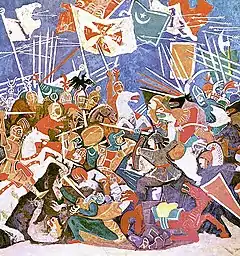 Petar Lubarda's Kosovski Boj | |||||||
| |||||||
| Belligerents | |||||||
|
|
| ||||||
| Commanders and leaders | |||||||
|
|
| ||||||
| Strength | |||||||
| ~ 27,000–40,000[B] | ~ 12,000–30,000[B] | ||||||
| Casualties and losses | |||||||
| Sultan Murad I and most of the troops[1][2] | Prince Lazar and most of the troops[1][2] | ||||||
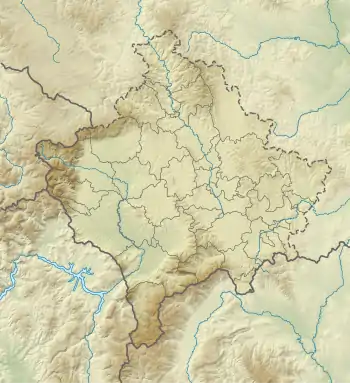 Location within Kosovo 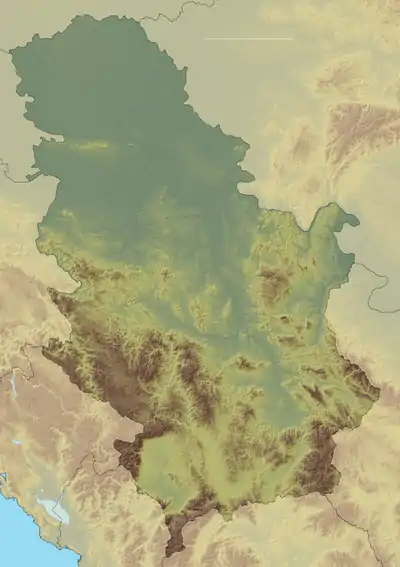 Battle of Kosovo (Serbia) 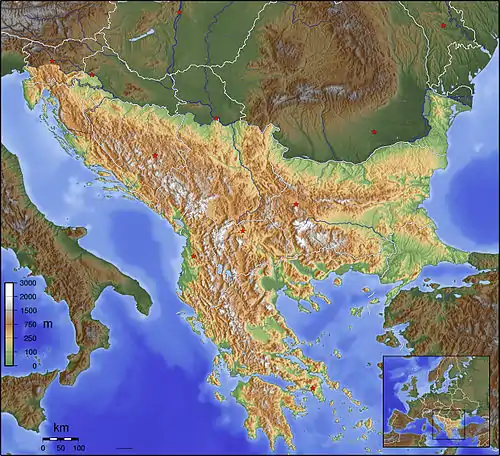 Battle of Kosovo (Balkans) | |||||||
Reliable historical accounts of the battle are scarce.[12] The bulk of both armies were wiped out, and Lazar and Murad were killed. Although the Ottomans managed to annihilate the Serbian army, they also suffered huge casualties that delayed their progress. The Serbs were left with too few men to effectively defend their lands, while the Turks had many more troops in the east. Consequently, the Serbian principalities that were not already Ottoman vassals became so consecutively in the following years.
Background
Emperor Stefan Uroš IV Dušan "the Mighty" (r. 1331–55) was succeeded by his son Stefan Uroš V "the Weak" (r. 1355–71), whose reign was characterized by the decline of central power and the rise of numerous virtually independent principalities; this period is known as the fall of the Serbian Empire. Uroš V was neither able to sustain the great empire created by his father, nor repulse foreign threats and limit the independence of the nobility; he died childless on 4 December 1371, after much of the Serbian nobility had been destroyed by the Ottomans in the Battle of Maritsa earlier that year. Prince Lazar, ruler of the northern part of the former empire (of Moravian Serbia), was aware of the Ottoman threat and began diplomatic and military preparations for a campaign against them.
After the defeat of the Ottomans at Pločnik (1386) and Bileća (1388), Murad I, the reigning Ottoman sultan, moved his troops from Philippoupolis to Ihtiman (modern Bulgaria) in the spring of 1388. From there they traveled across Velbužd and Kratovo (modern North Macedonia). Though longer than the alternative route through Sofia and the Nišava Valley, this led the Ottoman forces to Kosovo, one of the most important crossroads in the Balkans. From Kosovo, they could attack the lands of either Prince Lazar or Vuk Branković. Having stayed in Kratovo for a time, Murad and his troops marched through Kumanovo, Preševo, and Gjilan to Pristina, where he arrived on June 14.[13]
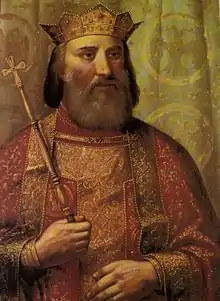 Prince Lazar Hrebeljanović
Prince Lazar Hrebeljanović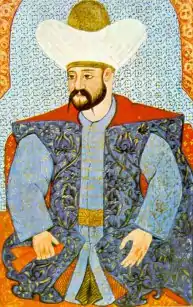 Sultan Murad Hüdavendigâr
Sultan Murad Hüdavendigâr
While there is less information about Lazar's preparations, he gathered his troops near Niš, on the right bank of the South Morava. His forces likely remained there until he learned that Murad had moved to Velbužd, whereupon he moved across Prokuplje to Kosovo. This was the best place he could choose as a battlefield, as it gave him control of all the routes that Murad could take.[13]
Reliable historical accounts of the battle are scarce; however, a critical comparison with historically contemporaneous battles (such as Ankara or Nikopolis) enables reliable reconstruction.[13]
Prelude
Army composition
Murad's army numbered between 27,000 and 40,000 men.[B][13] These included no more than 2,000 Janissaries,[14] 2,500 of Murad's cavalry guard, 6,000 sipahis, 20,000 azaps and akincis, and 8,000 troops from his vassals.[13] The Ottoman army was supported by the forces of the Anatolian Turkoman Beylik of Isfendiyar.[15]
Lazar's army numbered between 12,000 and 30,000.[B] According to a Yugoslav encyclopedia (1972), there were approximately 30,000 fighters present; 12,000-15,000 were under Lazar's command, with 5,000-10,000 under Vuk Branković, a Serbian nobleman from Kosovo, and just as many under a Bosnian nobleman Vlatko Vuković, sent by the Bosnian king Tvrtko I Kotromanić.[13] Also present were Knights Hospitaller led by the Croatian knight John of Palisna and several Albanian lords such as Gjon Kastrioti and Teodor Muzaka. Several thousand were knights.[16] There have been several anachronistic accounts that have mentioned the "Christian army" of Lazar was far greater, and that it also included contingents of other nations, although these cannot be verified.[C]
Troop deployment
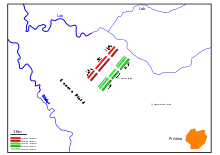
The armies met at the Kosovo field. Murad headed the Ottoman army, with his sons Bayezid on his right and Yakub on his left. Around 1,000 archers were in the front line in the wings, backed up by azap and akinci; in the front center were Janissaries, behind whom was Murad, surrounded by his cavalry guard; finally, the supply train at the rear was guarded by a small number of troops.[16] One of the Ottoman commanders was Pasha Yiğit Bey.[17]
The Serbian army had Prince Lazar at its center, Vuk on the right, and Vlatko on the left. At the front of the army were the heavy cavalry and archer cavalry on the flanks, with the infantry to the rear. While parallel, the dispositions of the armies were not symmetrical, as the Serbian center had a broader front than the Ottoman center.[16]
Battle
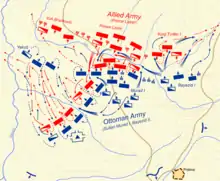
Serbian and Turkish accounts of the battle differ, making it difficult to reconstruct the course of events. It is believed that the battle commenced with Ottoman archers shooting at Serbian cavalry, who then made ready for the attack. After positioning in a wedge formation,[18] the Serbian cavalry managed to break through the Ottoman left wing, but were not as successful against the center and the right wing.[16]
The Serbs had the initial advantage after their first charge, which significantly damaged the Ottoman wing commanded by Yakub Çelebi.[19] When the knights' charge was finished, light Ottoman cavalry and light infantry counterattacked and the Serbian heavy armor became a disadvantage. In the center, Serbian troops managed to push back Ottoman forces, except for Bayezid's wing, which barely held off the Bosnians commanded by Vlatko Vuković. Vuković thus inflicted disproportionately heavy losses on the Ottomans. The Ottomans, in a ferocious counterattack led by Bayezid, pushed the Serbian forces back and then prevailed later in the day, routing the Serbian infantry. Both flanks still held, with Vuković's Bosnian troops drifting toward the center to compensate for the heavy losses inflicted on the Serbian infantry.
Historical facts say that Vuk Branković saw that there was no hope for victory and fled to save as many men as he could after Lazar was captured. In traditional songs, however, it is said that he betrayed Lazar and left him to die in the middle of battle, rather than after Lazar was captured and the center suffered heavy losses.
Sometime after Branković's retreat from the battle, the remaining Bosnian and Serb forces yielded the field, believing that a victory was no longer possible.
As the battle turned against the Serbs, it is said that one of their knights, later identified as Miloš Obilić, pretended to have deserted to the Ottoman forces. When brought before Murad, Obilić pulled out a hidden dagger and killed the Sultan by slashing him, after which the Sultan's bodyguards immediately killed him.
Aftermath
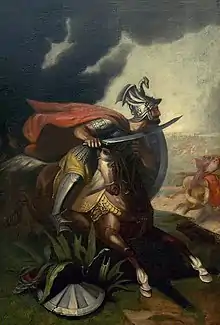
The earliest preserved record, a letter from the Florentine Senate to King Tvrtko I of Bosnia dated 20 October 1389, says that Murad was killed during the battle. The killer is not named, but it was one of 12 Serbian noblemen who managed to break through the Ottoman lines:
Fortunate, most fortunate are those hands of the twelve loyal lords who, having opened their way with the sword and having penetrated the enemy lines and the circle of chained camels, heroically reached the tent of Murat himself. Fortunate above all is that one who so forcefully killed such a strong vojvoda by stabbing him with a sword in the throat and belly. And blessed are all those who gave their lives and blood through the glorious manner of martyrdom as victims of the dead leader over his ugly corpse.[20]
Another Italian account, Mignanelli's work of 1416, asserted that it was Lazar who killed the Ottoman sultan.[21]
Both armies were broken by the battle.[11] Both Lazar and Murad lost their lives, and the remnants of their armies retreated from the battlefield. Murad's son Bayezid strangled his younger brother, Yakub Çelebi, upon hearing of their father's death, thus becoming the sole heir to the Ottoman throne.[22] The Serbs were left with too few men to defend their lands effectively, while the Turks had many more troops in the east.[11] Consequently, the Serbian principalities that were not already Ottoman vassals became so in the following years, yielding one by one.[11] Furthermore, in response to Ottoman pressure,[23] several Serbian noblemen wed their daughters, including the daughter of Prince Lazar, to Bayezid.[24][25] In the wake of these marriages, Stefan Lazarević became a loyal ally of Bayezid, going on to contribute significant forces to many of Bayezid's future military engagements, including the Battle of Nicopolis. Eventually the Serbian Despotate would, on numerous occasions, attempt to defeat the Ottomans in conjunction with the Hungarians until its final defeat in 1459.[26]
Legacy
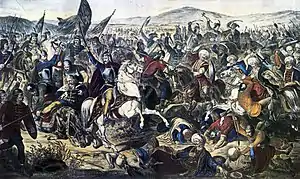
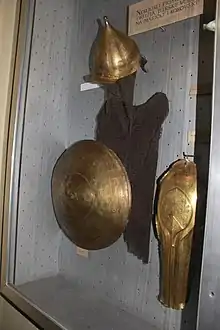
The Battle of Kosovo is particularly important to Serbian history, tradition and national identity.[27]
The day of the battle, known in Serbian as Vidovdan (St. Vitus' day) and celebrated according to the Julian calendar (corresponding to 28 June Gregorian in the 20th and 21st centuries), is an important part of Serb ethnic and national identity,[28] with notable events in Serbian history falling on that day: in 1876 Serbia declared war on the Ottoman Empire (Serbian–Ottoman War (1876–78); in 1881 Austria-Hungary and the Principality of Serbia signed a secret alliance; in 1914 the assassination of Archduke Franz Ferdinand of Austria was carried out by the Serbian Gavrilo Princip (although a coincidence that his visit fell on that day, Vidovdan added nationalist symbolism to the event[29]); in 1921 Serbian King Alexander I proclaimed the Vidovdan Constitution; in 1989, on the 600th anniversary of the battle, Serbian political leader Slobodan Milošević delivered the Gazimestan speech on the site of the historic battle.
The Tomb of Sultan Murad, a site in Kosovo Polje where Murad I's internal organs were buried, has gained a religious significance for local Muslims. A monument was built by Murad I's son Bayezid I at the tomb, becoming the first example of Ottoman architecture in the Kosovo territory.
See also
Notes
- ^ Date: Some sources attempt to give the date as June 28 in the New-Style Gregorian calendar, but that was not adopted until 1582, and did not apply retrospectively (but see Proleptic Gregorian calendar). Moreover, the proleptic Gregorian date of the battle is June 23, not 28. Nevertheless, anniversaries of the battle are still celebrated on June 15 Julian (Vidovdan, that is St. Vitus' Day in the calendar of the Serbian Orthodox Church, which is still Julian), which corresponds to June 28 Gregorian in the 20th and 21st centuries.
- ^ a b c Strength: Estimate vary, although with the Ottomans having greater numbers;
- According to Sedlar: "Nearly the entire Christian fighting force (between 12,000 and 20,000 men) had been present at Kosovo, while the Ottomans (with 27,000 to 30,000 on the battlefield) retained numerous reserves in Anatolia."[30]
- According to J. K. Cox: "The Ottoman army probably numbered between 30,000 and 40,000. They faced something like 15,000 to 25,000 Eastern Orthodox soldiers."[6]
- According to Cowley: "On June 28, 1389, an Ottoman army of between thirty thousand and forty thousand under the command of Sultan Murad I defeated an army of Balkan allies numbering twenty-five thousand to thirty thousand under the command of Prince Lazar of Serbia at Kosovo Polje (Field of Blackbirds) in the central Balkans."[31]
- ^ According to some Turkish sources, the "Christian army" led by Prince Lazar included contingents of Bulgarians, Albanians, Wallachians, Germans and Bohemians.[32] Claims about such a coalition of Christian rulers first appeared about eighty years after the battle in a book written by an Ottoman author, Oruç of Edirne, and were repeated by later Turkish historians.[33] Some of them added also Franks, and Czechs to the aforementioned troops, claiming that there were 500,000 soldiers in the "Christian coalition". The reason for the Ottomans to represent the Battle of Kosovo in this way might lie in the fact that it was the only battle in which an Ottoman sultan was killed.[33] The alleged participation of Đurađ II Balšić, the lord of Zeta, in Lazar's army is improbable: he had previously become an Ottoman vassal; he was in hostility with Lazar's ally Tvrtko I; and at the time of the battle he was most likely in Ulcinj.[34] The participation of Teodor Muzaka and other Albanians is suggested by a family history of the Muzaka (Musachi) family,[34] written in Naples in c. 1515 by John Musachi, who stated the following: "Lazar, the Despot of Serbia, and King Marko of Bulgaria (Bulgaria's monarch in 1389 was Tsar Ivan Shishman, who had been under the Ottoman overlordship since 1373. King Marko is referred to also as the king of Serbia in John Musachi's chronicle.) and Theodore Musachi, (Theodore Musachi is the younger brother of John Musachi's father, Gjin. According to the chronicle, Theodore died in the Battle of Kosovo, about 125 years before his nephew wrote the chronicle.) and the other Lords of Albania united and set off for battle, which the Christians lost."[35] Robert Elsie, an expert on Albanian studies, characterizes John Musachi's chronicle as "no work of great scholarship" whose historical accounts are confusing, although it is an important source for late 15th-century Albania.[35]
Status of Kosovo
- Kosovo is the subject of a territorial dispute between the Republic of Kosovo and the Republic of Serbia. The Republic of Kosovo unilaterally declared independence on 17 February 2008. Serbia continues to claim it as part of its own sovereign territory. The two governments began to normalise relations in 2013, as part of the 2013 Brussels Agreement. Kosovo is currently recognized as an independent state by 98 out of the 193 United Nations member states. In total, 113 UN member states recognized Kosovo at some point, of which 15 later withdrew their recognition.
References
Citations
- (Fine 1994, p. 410)
Thus since the Turks also withdrew, one can conclude that the battle was a draw.
- (Emmert 1990, p. ?)
Surprisingly enough, it is not even possible to know with certainty from the extant contemporary material whether one or the other side was victorious on the field. There is certainly little to indicate that it was a great Serbian defeat; and the earliest reports of the conflict suggest, on the contrary, that the Christian forces had won.
- Daniel Waley; Peter Denley (2013). Later Medieval Europe: 1250-1520. Routledge. p. 255. ISBN 978-1-317-89018-8.
The outcome of the battle itself was inconclusive.
- Ian Oliver (2005). War and Peace in the Balkans: The Diplomacy of Conflict in the Former Yugoslavia. I.B.Tauris. p. vii. ISBN 978-1-85043-889-2.
Losses on both sides were appalling and the outcome inconclusive although the Serbs never fully recovered.
- John Binns (2002). An Introduction to the Christian Orthodox Churches. Cambridge University Press. p. 197. ISBN 978-0-521-66738-8.
The battle is remembered as a heroic defeat, but historical evidence suggests an inconclusive draw.
- John K. Cox (2002). The History of Serbia. Greenwood Publishing Group. p. 30. ISBN 978-0-313-31290-8.
The Ottoman army probably numbered between 30,000 and 40,000. They faced something like 15,000 to 25,000 Eastern Orthodox soldiers. [...] Accounts from the period after the battle depict the engagement at Kosovo as anything from a draw to a Christian victory.
- Heike Krieger (2001). The Kosovo Conflict and International Law: An Analytical Documentation 1974-1999. Cambridge University Press. p. 31. ISBN 0-521-80071-4.
Discussions of the Kosovo conflict often start with the battle of Kosovo Polje (the Field of Blackbirds) in 1389 when the Serbs were defeated by the Ottoman Empire
- Michael Waller; Kyril Drezov; Bülent Gökay (2013). Kosovo:The Politics of Delusion. Routledge. p. 172. ISBN 978-0-7146-5157-6.
1389: A Serbian-led Christian army (including Albanians) suffers a catastrophic defeat by Ottoman forces at the Battle of Kosovo.
- Petar V. Grujic (2014). Kosovo Knot. RoseDog Books. p. 39. ISBN 978-1-4809-9845-2.
In the epic battle of Kosovo Polje, just west from present-day Pristina, Serb grand duke (knez) Lazar Hrebeljanovic, who led the joined Christian forces, lost the battle (and life) to Turkish sultan Murad I
- Tonny Brems Knudsen; Carsten Bagge Laustsen (2006). Kosovo between war and peace. Routledge. p. 23. ISBN 0-714-65598-8.
The highpoint of this conflict, the Battle of Kosovo Polje, ended in Serbian defeat and the death of Prince Lazar, beheaded by the Turks
- (Fine 1994, pp. 409–411)
- https://www.intermagazin.rs/istorija-koju-nismo-ucili-na-casovima-milos-obilic-je-bio-turski-zatocnik-ali-jeste-ubio-murata-na-kosovu/
- (Vojna Akademija 1972, p. 659)
- Hans-Henning Kortüm (2006). Transcultural wars from the Middle Ages to the 21st century. Akademie. p. 231. ISBN 978-3-05-004131-5.
But having been established under Murad I (1362-1389), essentially as a bodyguard, the Janissaries cannot have been present in large numbers at Nicopolis (there were no more than 2,000 at Kosovo in 1389)
- Karpat, Kemal H.; Zens, Robert W. (2003). Ottoman Borderlands: Issues, Personalities, and Political Changes. Center of Turkish Studies, University of Wisconsin. p. 35. ISBN 978-0-299-20024-4.
Troops of his emirate seconded Murad I in the battle of Kosovo Polje (1389), as indicated in the "Book of Victory" (Fatih-name) issued by Bayezid the Thunderbolt.
- (Vojna Akademija 1972, p. 660)
- Evliya Çelebi; Hazim Šabanović (1996). Putopisi: odlomci o jugoslovenskim zemljama. Sarajevo-Publishing. p. 280. Retrieved 26 July 2013.
Paša Jigit- -beg, koji se prvi put pominje kao jedan između turskih komandanata u kosovskoj bici.
- Slavomir Nastasijevic (1987). Vitezi Kneza Lazara. Narodna Knjiga Beograd. pp. 187–. ISBN 8633100150.
Serbian heavy cavalry took V wedge shape charge position breaking through Ottoman infantry and light cavalry.
- (Emmert 1991, p. ?)
- Wayne S. Vucinich, Thomas A. Emmert (1991). Kosovo: Legacy of a Medieval Battle. University of Minnesota. ISBN 9789992287552.
- Sima M. Ćirković (1990). Kosovska bitka u istoriografiji: Redakcioni odbor Sima Ćirković (urednik izdanja) [... et al.]. Zmaj. p. 38. Retrieved 11 September 2013.
Код Мињанелиjа, кнез је претходно заробл - ен и принуЬен да Мурату положи заклетву верности! и тада је један од њих, кажу да је то био Лазар, зарио Мурату мач у прса
- Imber, Colin. The Ottoman Empire: The Structure of Power, 2nd ed. New York: Palgrave Macmillan, 2009, p. 85. ISBN 0-230-57451-3.
- Vamik D. Volkan (1998). Bloodlines: From Ethnic Pride to Ethnic Terrorism. Westview Press. p. 61. ISBN 978-0-8133-9038-3.
- Donald Quataert (11 August 2005). The Ottoman Empire, 1700-1922. Cambridge University Press. p. 26. ISBN 978-0-521-83910-5.
- History of the Ottoman Empire and Modern Turkey By Stanford Jay Shaw, Ezel Kural Shaw, p. 24
- Fine, John (1994). The Late Medieval Balkans: A Critical Survey from the Late Twelfth Century to the Ottoman Conquest. University of Michigan Press. p. 575. ISBN 9780472082605.
- Isabelle Dierauer (16 May 2013). Disequilibrium, Polarization, and Crisis Model: An International Relations Theory Explaining Conflict. University Press of America. p. 88. ISBN 978-0-7618-6106-5.
- Đorđević 1990.
- Manfried Rauchensteiner, Der Erste Weltkrieg und das Ende der Habsburgermonarchie 1914–1918, 2013, p. 87
- Sedlar, Jean W. East Central Europe in the Middle Ages, 1000-1500. University of Washington Press. p. 244.
Nearly the entire Christian fighting force (between 12,000 and 20,000 men) had been present at Kosovo, while the Ottomans (with 27,000 to 30,000 on the battlefield) retained numerous reserves in Anatolia.
- Cowley, Robert; Geoffrey Parker. The Reader's Companion to Military History. Houghton Mifflin Books. p. 249.
On June 28, 1389, an Ottoman army of between thirty thousand and forty thousand under the command of Sultan Murad I defeated an army of Balkan allies numbering twenty-five thousand to thirty thousand under the command of Prince Lazar of Serbia at Kosovo Polje (Blackbird's Field) in the central Balkans.
- Željko Fajfrić. "7. Bitka na Kosovu". Sveta loza kneza Lazara.
[...] Nije knez mogao računati ni na Vlaškog vojvodu Mirčeta jer je ovaj ratovao protiv Ugara po Poljskoj, ali ni na svoga zeta Bugarskog cara Šišmana. Još su neosnovanije bile tvrdnje da su knezu pomagali Albanci. Stoga svi kasniji navodi, naročito Turski, gde se tvrdi da je knez Lazar uspeo da okupi oko sebe Bugare, Albance, Vlahe pa čak Nemce i Čehe, jesu najobičnija izmišljotina koja je imala za zadatak da kneževu snagu preuveličaju. [Lazar could not count on Wallachian voivode Mirčeta as he was in war with the Hungarians in Poland, nor on Bulgarian Emperor Šišman. Even more ungrounded is the claim that Albanians aided Lazar. All the later mentions, particularly the Turkish, where it is claimed that Lazar managed to gather the Bulgarians, Albanians, Wallachians, and even Germans and Czechs, are the commonest of fabrications which have the intention to exaggerate the size of Lazar's forces.]
- Antić, Čedomir (25 November 2010). "Bitka za bitku" (in Serbian). Politika Online.
- Malcolm, Noel (1998). Kosovo: A Short History. London: Macmillan. p. 62
- Elsie, Robert (2003). "1515. John Musachi: Brief Chronicle on the Descendants of our Musachi Dynasty Archived 2010-09-10 at the Wayback Machine". Documents 16th to 18th centuries. Texts and Documents of Albanian History.
Sources
- Vojna Akademija (1972). "Kosovska bitka". Vojna Enciklopedija (in Serbo-Croatian). Belgrade: Vojnoizdavački zavod JNA.
- John V. A. Fine; John Van Antwerp Fine (1994). The Late Medieval Balkans: A Critical Survey from the Late Twelfth Century to the Ottoman Conquest. University of Michigan Press. ISBN 0-472-08260-4.
- Emmert, Thomas Allan (1991)."The Battle of Kosovo: Early Reports of Victory and Defeat". Archived from the original on 2011-07-16. Retrieved 2008-05-17.CS1 maint: bot: original URL status unknown (link) . Kosovo: Legacy of a Medieval Battle. Minneapolis: University of Minnesota Press. ISBN 9789992287552
Further reading
- Bieber, Florian. "Nationalist mobilization and stories of Serb suffering: The Kosovo myth from 600th anniversary to the present." Rethinking history 6.1 (2002): 95-110. online
- Ćirković, Sima (2004). The Serbs. Malden: Blackwell Publishing. ISBN 9781405142915.
- Rade Mihaljčić (1989). The Battle of Kosovo in history and in popular tradition. Beogradski izdavačko-grafički zavod.
- Lugar, Peter B. "The History and Effects of the Kosovo Polje Mythology" (Army Command and General Staff College 2005). [https://apps.dtic.mil/sti/pdfs/ADA437497.pdf online[
- Gliša Elezović; Neșrı̂ (1940). Boj na Kosovu 1389 g. u istoriji Mula Mehmeda Nešrije. Štamp. "Luč".
- Branislav Đerić (1989). Kosovska bitka: vojno-istorijska rasprava. Naučna knjiga.
- Ćirković, Sima M. (1990). Kosovska bitka u istoriografiji. Zmaj.
- Petar Tomac (1968). Kosovska bitka. Vojnoizdavački zavod.
- Jov Mišković (1933). Kosovska bitka 15. juna 1389. godine. Planeta.
- Nikola Kusovac (1988). Kosovska bitka: mit, legenda i stvarnost. Litera.
- Emmert, Thomas Allan (1990). Serbian Golgotha: Kosovo, 1389. East European Monographs. ISBN 978-0-88033-175-3.
- Tihomir Ostojić (1901). Kosovo: narodne pesme o boju na Kosovu 1389. godine. Izd. Matice Srpske. pp. 91–.
External links
| Wikimedia Commons has media related to Battle of Kosovo. |
- Charles Simic, ed. (1987). "Serbian Epic Poems - The Battle of Kosovo". Rastko. Archived from the original on 2014-11-04.
